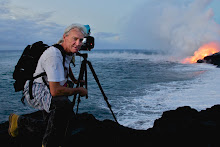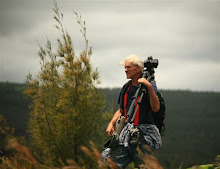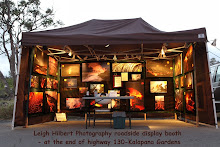
USGS image -Looking southwest at Pu`u O`o.
Orange-red reflective lava glow was visible from many miles distant last night as a new, and sizable, thrust of flowing lava spewed from the flanks of Pu`u O`o Crater and is heading downhill.

As the evening progressed last night, I watched the reflective bright glow of the new lava flow from my home in Kapoho, which is twenty miles away, and snapped this image above with a 300mm lens. The mountain silhouetted is the Green Mountain volcano.
Yesterday on the USGS/HVO Kilauea volcano update page yesterday described the first faze of the breakouts like this: “
At about 2:25 AM, lava broke through the upper east flank of Pu`u `O`o and a channelized flow advanced rapidly downslope to the east. Seismic tremor levels are low, but increased at Pu`u `O`o when the new fissure opened. Gas emissions from the summit and east rift zone vents remain elevated. All erupted lava is within Hawai`i Volcanoes National Park or adjacent State land managed by the Department of Land and Natural Resources. If the eastern flows persist, they may pose a hazard to the Royal Gardens subdivision in the coming days. The flow's progress will be assessed during an overflight this afternoon.” The rivers of lava have moved a lot further since that posting; they will have a new update today.
There was a very steep increase in magma pressures within the tubing system feeding the Pu`u O`o its lava. Check out the graph below for yesterday’s spike.

I phoned the Janguard Security personnel who operate the Hawaii County Civil Defense Lava Viewing site adjacent to Kalapana Gardens and asked what they could see from there. Road manager David said there was no lava visible from there but the mountain lava glow was the brightest to be seen in quite awhile, and that many local people were driving down to take a look; as word spread about the red lava skies being seen from across the lower Puna district.
All the
Kilauea webcams were showing heightened eruption lava yesterday and last night. Check them all out today too.

Here, above, is the
cam that faces east from below Pu`u O`o. The bright white spots are the new lava rivers. Here is the same view this morning from the cam:

 Halema`uma`u Crater overlook
Halema`uma`u Crater overlook(above) and wide-view cam (below) at the Jaggar museum also had strong eruptive activity, as shown below at 11:00 PM last night.

If the activity continues today, I may drive out to Kalapana after dark and see what the lava glow looks like. New lava flowing down the Pulama Pali would be exciting, and if it makes it that far it would likely be well west of any homes but highly visible from the lava viewing site.
I’ll keep you posted as noteworthy changes occur ~~~
And check with the guys up on the volcano for their excellent
updates and images If you want to see an in-depth study of all the known Big Island lava flows up to 2006) this
pdf USGS topography map has a great detailed history laid out.
 Bright yellow-orange-red lava reflects beneath afterglow sunset light at 7:00 PM last night from Kalapana Gardens: some of the pictures I took last night from a friends place within the subdivision.
Bright yellow-orange-red lava reflects beneath afterglow sunset light at 7:00 PM last night from Kalapana Gardens: some of the pictures I took last night from a friends place within the subdivision.  (Click on these images for a larger size and see the stars) Looking west at 8:00 PM last night. For perspective, the bright fan-shaped white glow on the lower right is from the Hawaii County viewing site parking lot. You can also just make out some of the homes in the Gardens.
(Click on these images for a larger size and see the stars) Looking west at 8:00 PM last night. For perspective, the bright fan-shaped white glow on the lower right is from the Hawaii County viewing site parking lot. You can also just make out some of the homes in the Gardens. Small random earthquakes continue all around the Big Island, most densely clustered near Kilauea.
Small random earthquakes continue all around the Big Island, most densely clustered near Kilauea. 




















